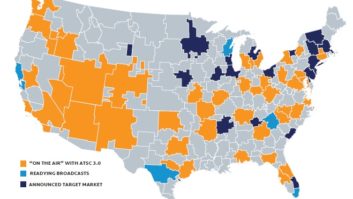NAB EVP/CTO Kevin Gage says the sweet spot for radio is getting into a mobile device.
Monday, he and other representatives of core proponents working on getting FM HD Radio chips embedded into mobile phones and other devices unveiled a prototype cellphone manufactured by ZTE, an HD Radio app and a backend system, to insert and track ads and associated data all the way from automation system to broadcast.
“In 2012, a car is a smartphone with four wheels,” said iBiquity Digital Bob Struble. iBiquity, along with Emmis Interactive, Intel, and BIA/Kelsey in a project management role, were tasked by NAB Labs a year ago to make an HD Radio smartphone ecosystem happen.
Emmis Interactive is calling the broadcast insertion system “TagStation.” The system pairs HD Radio broadcasts with the phone’s data channel to deliver features like couponing, geo-location ads and other features that Emmis Interactive Founder and Co-President Rey Mena says is a more interactive experience; it incorporates Artist Experience, in which album art and other images are synched with HD Radio audio, and more.
The point was to make the HD Radio experience for the user interactive and standardize the experience so the user and advertisers know what to expect from station to station, Mena added.
Emmis Communications Chairman and CEOJeff Smulyan, who’s been trying to convince cellphone carriers to embed and activate FM HD Radio chips in mobile devices for about four years, said “We think this gives us the opportunity to compete in every appliance out there, “ meaning cellphones, media players, tablets and cars, for example.
By clicking on the so-called thunderbolt-shaped “action button” on the device, the user can perform a variety of functions, from getting a QR code or making a purchase.
At the station, with the Tag Station user interface, personnel can see the ads coming into a system, change the associated image with that ad, and most useful, track what consumers do with those ads.
The next step is convincing carriers to go along with the concept; Smulyan said that is both the radio industry and NAB’s number one priority right now.






